Experimental Study on a Hydrogen Stratification Induced by PARs Installed in a Containment
Abstract
1. Introduction
2. SPARC-PAR Test Facility
3. PAR Performance
- -
- : hydrogen concentration [vol.%];
- -
- p: pressure [bar];
- -
- T: temperature [K];
- -
- Values of constant parameters: ;
- -
- N: size factor, 1 for KPAR-40, 2 for KPAR-80, and 4 for KPAR-160
4. Test Conditions for SPARC-PAR Experiments
5. Experimental Results
5.1. SP1 Test
5.2. SP3 Test
5.3. SP5 Test
5.4. Visualization of Hydrogen Stratification
6. Conclusions
Author Contributions
Funding
Acknowledgments
Conflicts of Interest
References
- US-NRC. Combustible Gas Control for Nuclear Power Reactors, NRC Regulations 10CFR 50.44. Available online: https://www.nrc.gov/reading-rm/doc-collections/cfr/part050/part050-0044.html (accessed on 2 September 2020).
- Korea Institute of Nuclear Safety. Safety Review Guidelines for Light Water Reactors (Revision 6); KINS/GE-N001; Korea Institute of Nuclear Safety: Daejeon, Korea, 2016. [Google Scholar]
- IAEA. Mitigation of Hydrogen Hazards in Severe Accidents in Nuclear Power Plants; IAEA-TECDOC-1661; International Atomic Energy Agency: Wien, Austria, 2011. [Google Scholar]
- OECD/NEA. Status Report on Hydrogen Management and Related Computer Codes; Nuclear Safety NEA/CSNI/R(2014) 8 June 2014; OECD/NEA: Issy-les-Moulineaux, France, 2014. [Google Scholar]
- Arnould, F.; Bachellerie, E.; Auglaire, M.; Boeck, B.; Braillard, O.; Eckardt, B.; Ferroni, F.; Moffett, R. Goethem. State of the Art on Hydrogen Passive Autocatalytic Recombiner. In Proceedings of the 9th International Conference of Nuclear Engineering, Nice, France, 8–12 April 2001. [Google Scholar]
- IAEA. Mitigation of Hydrogen Hazards in Water Cooled Power Reactors; IAEA-TECDOC-1196; International Atomic Energy Agency: Wien, Austria, 2001. [Google Scholar]
- Kim, J.; Hong, S.W. Development of a Numerical Method for PAR Analysis; Technical Report KAERI/TR-5759; Korea Atomic Research Institute: Daejeon, Korea, 2014. [Google Scholar]
- Westinghouse. AP1000 Pre-Construction Safety Report, UKP-GW-GL-732. 2010. Available online: https://www.namrc.co.uk/wp-content/uploads/2011/04/AP1000-safety-report.pdf (accessed on 1 March 2015).
- AREVA Passive Autocatalytic Recombiner. Available online: http://us.areva.com/home/liblocal/docs/Solutions/literature/G-008-V1PB-2011-ENG_PAR_reader.pdf (accessed on 1 September 2019).
- Kelm, S.; Jahn, W.; Reinecke, E.-A. Operational Behavior of Catalytic Recombiners—Experimental Results and Modelling Approaches. In Proceedings of the workshop on Experiments and CFD Code Application to Nuclear Reactor Safety XCFD4NRS, Computational Fluid Dynamics in Nuclear Reactor Safety, Grenoble, France, 10–12 September 2007. [Google Scholar]
- Bachellerie, E.; Arnould, F.; Auglaire, M.; Boeck, B.; Braillard, O.; Eckardt, B.; Ferroni, F.; Moffett, R. Generic Approach for Designing and Implementing a Passive Autocatalytic Recombiner PAR-System in Nuclear Power Plant Containments. Nucl. Eng. Des. 2003, 221, 151–165. [Google Scholar] [CrossRef]
- Dewit, W.A.; Koroll, G.W.; Sitar, L. Hydrogen Recombiner Development at AECL, AECL-1172 NEA/CSNI(96)8; Atomic Energy of Canada Limited: Chalk River, ON, Canada, 1996. [Google Scholar]
- Passive Autocatalytic Recombiner (PARs), SNC-LAVALIN AECL. Available online: www.snclavalin.com/nuclear (accessed on 1 September 2020).
- Park, J.W.; Koh, B.R.; Suh, K.Y. Demonstrative testing of honeycomb passive autocatalytic recombiner for nuclear power plant. Nucl. Eng. Des. 2011, 241, 4280–4288. [Google Scholar] [CrossRef]
- Kim, C.H.; Sung, J.J.; Ha, S.J.; Yeo, I.S. Analysis Method for the Design of a Hydrogen Mitigation System with Passive Autocatalytic Recombiners in OPR1000, PBNC2014-072. In Proceedings of the 19th Pacific Basin Nuclear Conference (PBNC 2014), Vancouver, BC, Canada, 24–28 August 2014. [Google Scholar]
- Kanzleiter, T.; Gupta, S.; Fischer, K.; Ahrens, G.; Langer, G.; Kühnel, A.; Poss, G.; Langrock, G.; Funke, F. Hydrogen and Fission Product Issues Relevant for Containment Safety Assessment under Severe Accident Conditions; Final Report OECD-NEA THAI Project; Organisation for Economic Co-operation and Development/Nuclear Energy Agency: Paris, France, 2010. [Google Scholar]
- Reinecke, E.-A.; Bentaib, A.; Kelm, S.; Jahn, W.; Meynet, N.; Caroli, C. Open Issues in the Applicability of Recombiner Experiments and Modeling to Reactor Simulations. Prog. Nucl. Energy 2010, 52, 136–147. [Google Scholar] [CrossRef]
- Meynet, N.; Bentaib, A. Numerical Study of Hydrogen Ignition by Passive Auto-Catalytic Recombiners. Nucl. Technol. 2012, 178, 17–28. [Google Scholar] [CrossRef]
- Gupta, S.; Kanzleiter, T.; Poss, G. Passive Auto-Catalytic Recombiners PAR Induced Ignition and the Resulting Hydrogen Deflagration Behavior in LWR Containment, NURETH-16. In Proceedings of the 16th International Topical Meeting on Nuclear Reactor Thermal Hydraulics, Chicago, IL, USA, 31 August 2015. [Google Scholar]
- Rozen, A. Simulation of Start-up Behavior of a Passive Autocatalytic Hydrogen Recombiner. Nucleonika 2018, 63, 27–41. [Google Scholar] [CrossRef]
- Simon, B.; Reinecke, E.-A.; Kubelt, C.; Allelein, H.-S. Start-up Behavior of a Passive Auto-catalytic Recombiner under Counter Flow Conditions: Results of a First Orienting Experimental Study. Nucl. Eng. Des. 2014, 278, 317–322. [Google Scholar] [CrossRef]
- Reinecke, E.A.; Tragsdorf, I.M.; Gierling, K. Studies on innovative hydrogen recombiners as safety devices in the containments of light water reactors. Nucl. Eng. Des. 2004, 230, 49. [Google Scholar] [CrossRef]
- Kim, J.; Kim, H.T.; Hong, S. Data Analysis of SPARC Experiment for PARs Installed in a Nuclear Reactor Containment; Technical Report KAERI/TR-8015; Korea Atomic Research Institute: Daejeon, Korea, 2020. [Google Scholar]
- Kim, J.; Kim, H.T.; Park, R.-J. Research on a Hydrogen Stratification Induced by PARs Installed in a Containment. In Proceedings of the Transactions of the Korean Nuclear Society Autumn Meeting, Yeosu, Korea, 25–26 October 2018. [Google Scholar]
- Gupta, S. Personal Communication; Becker Tech.: Pune, India, 2018. [Google Scholar]
- ParaView by Kitware. Available online: www.paraview.org (accessed on 1 September 2020).
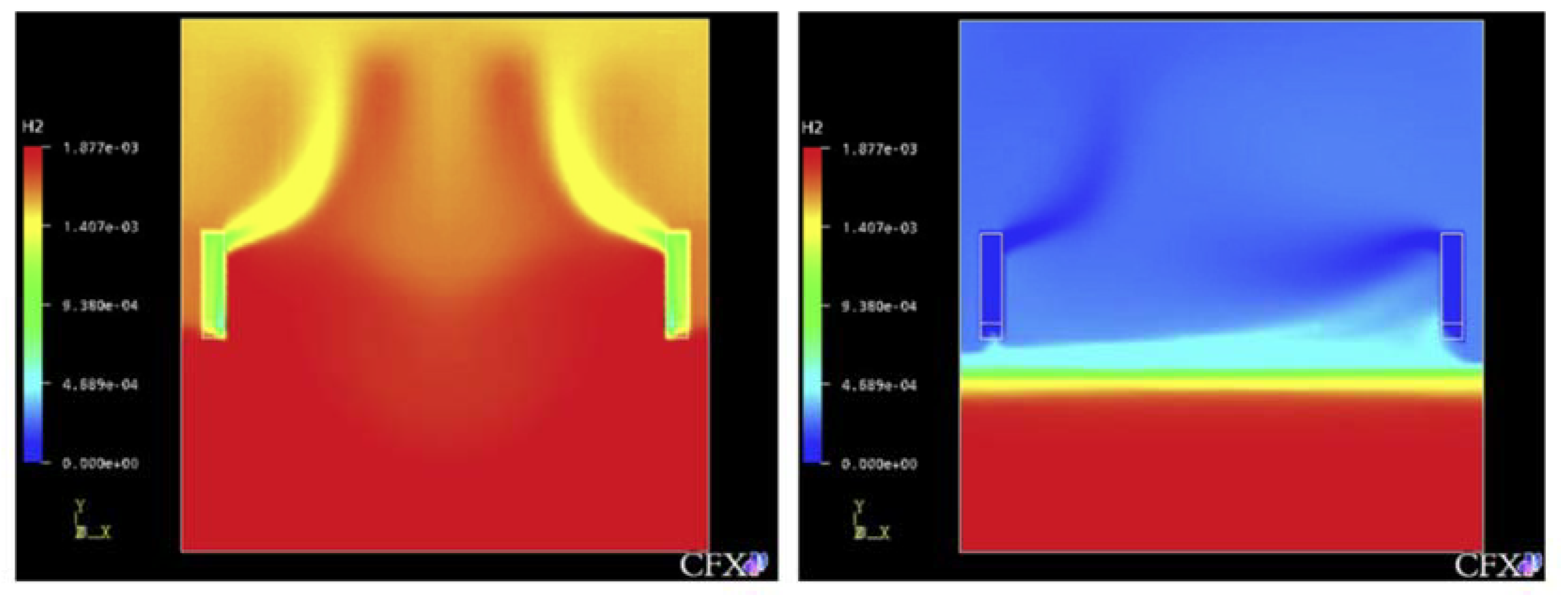
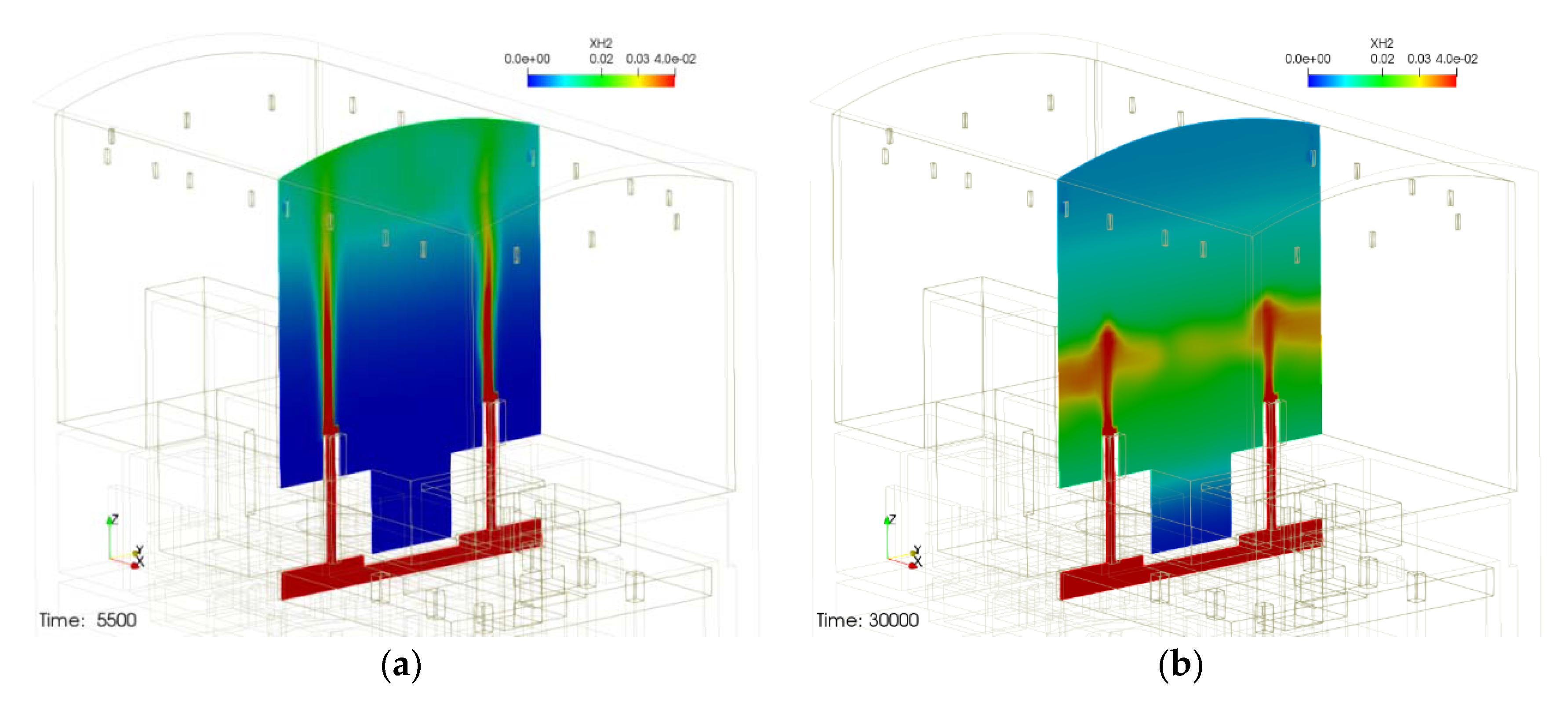
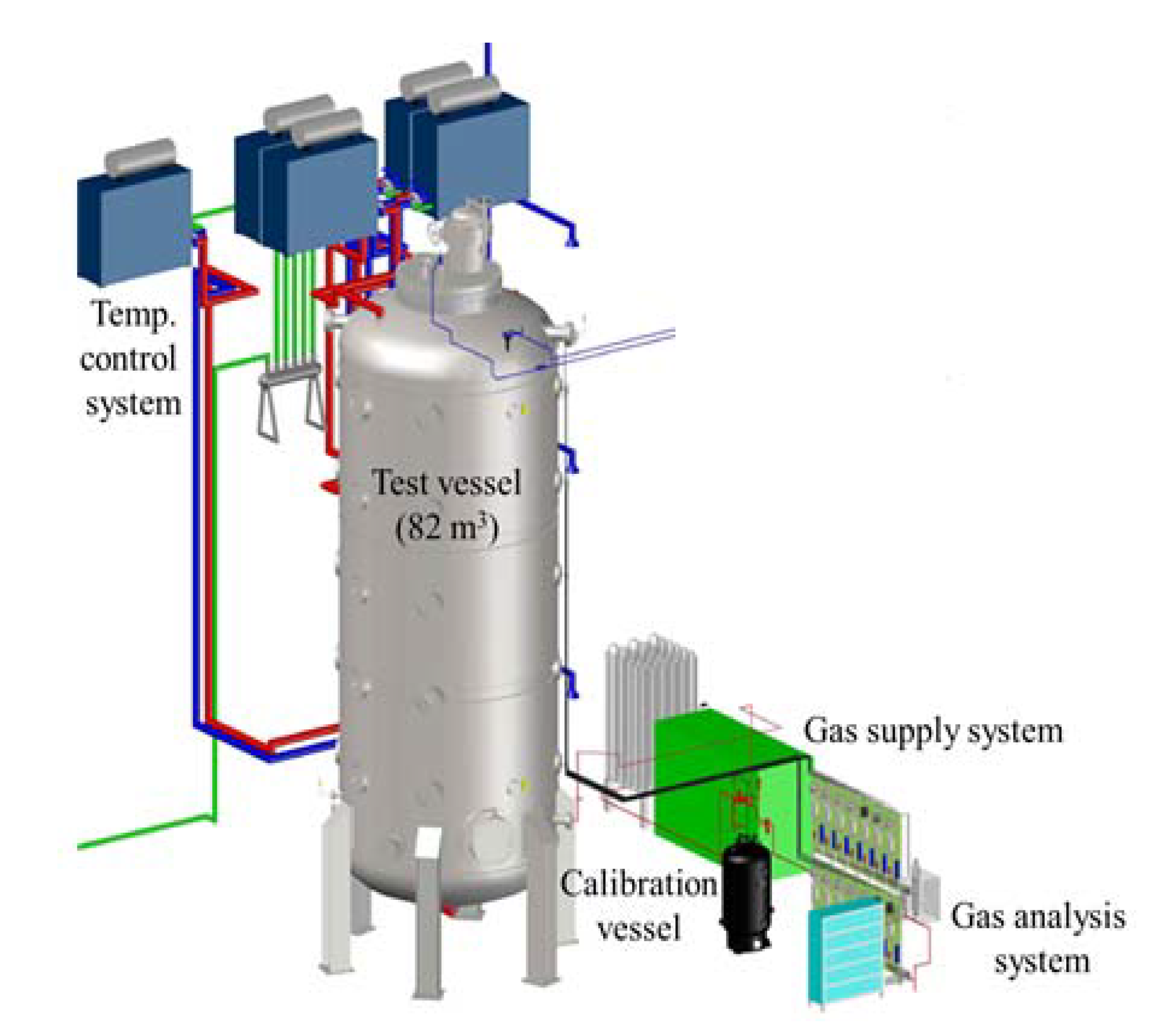

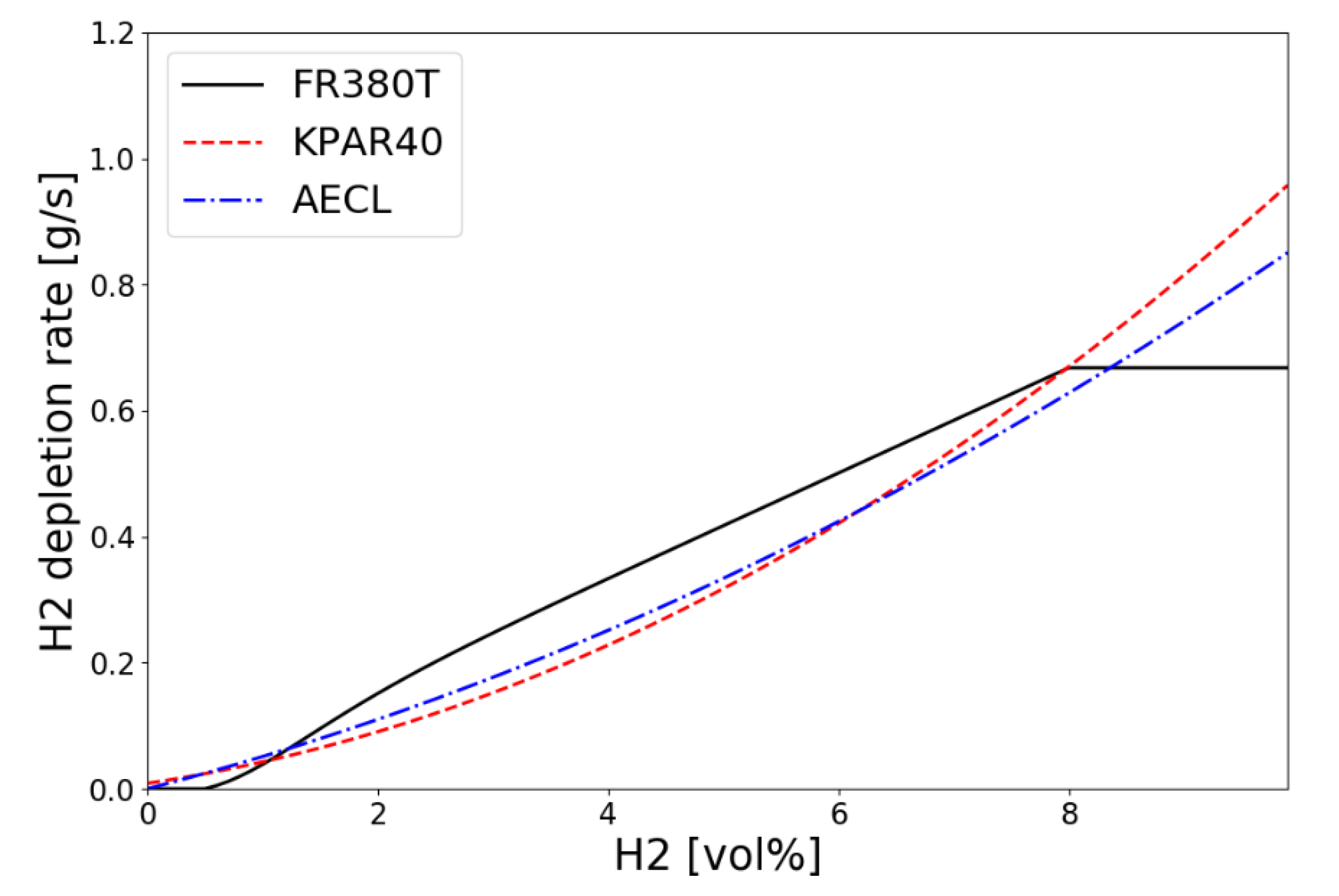
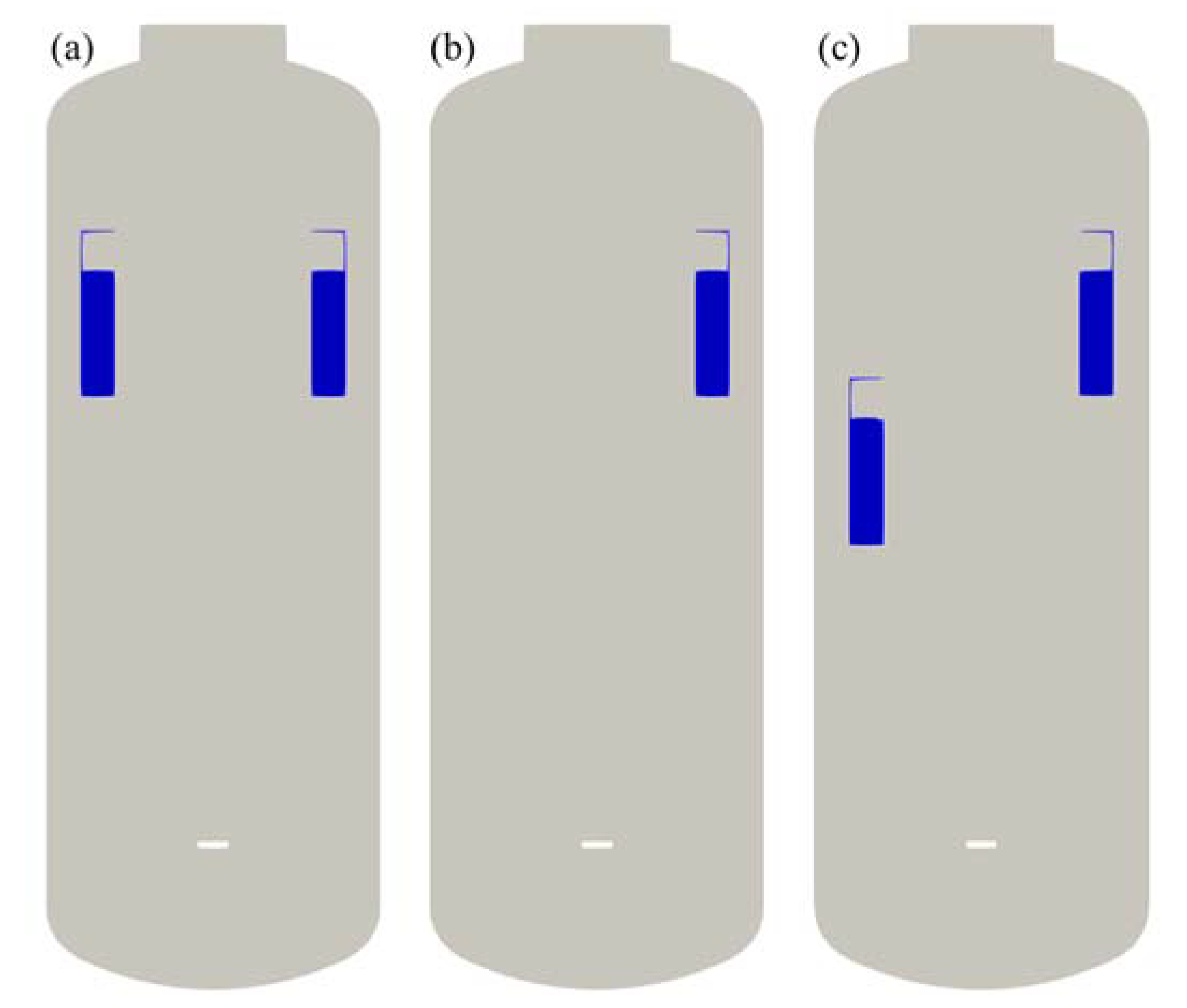
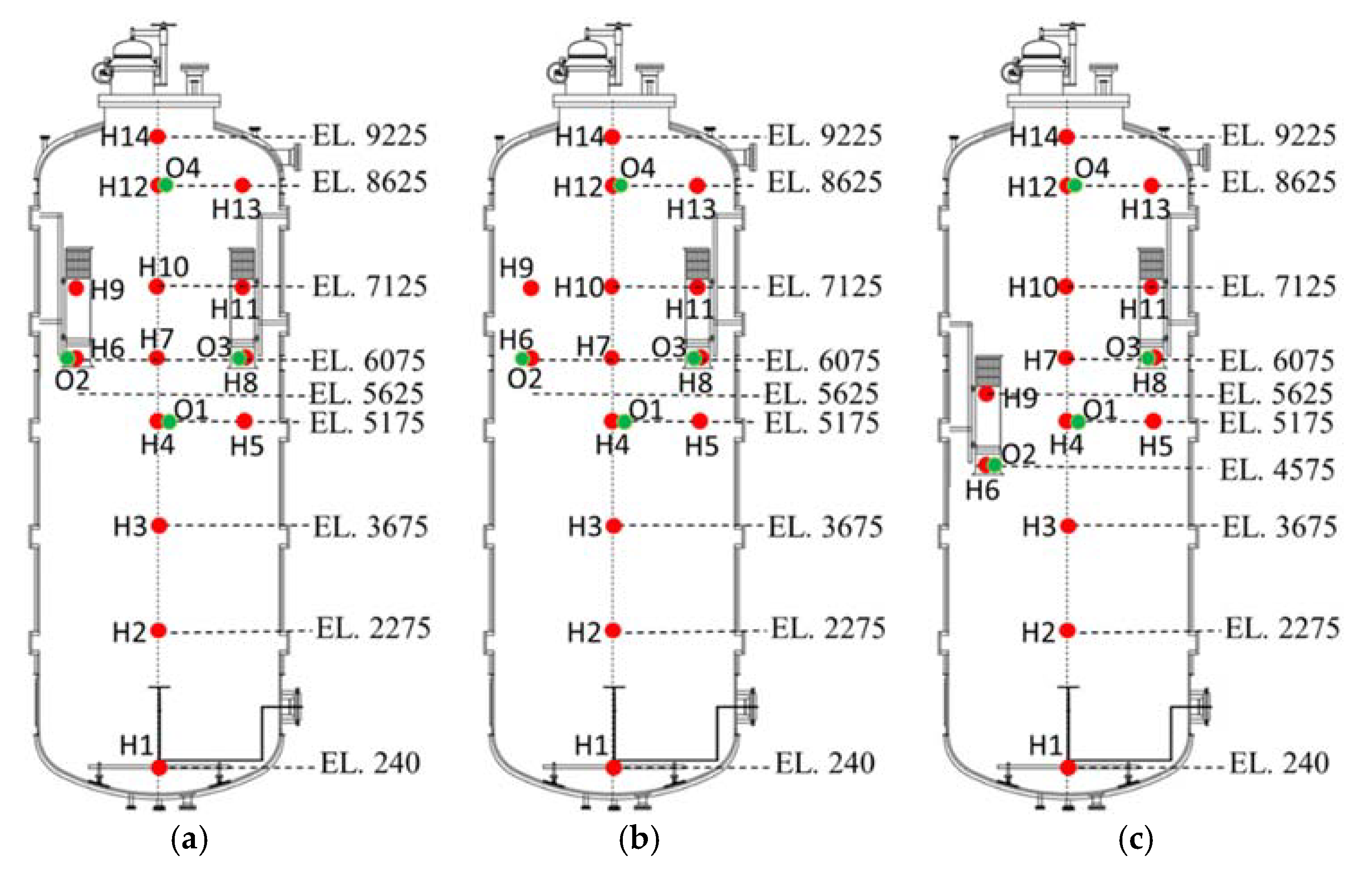
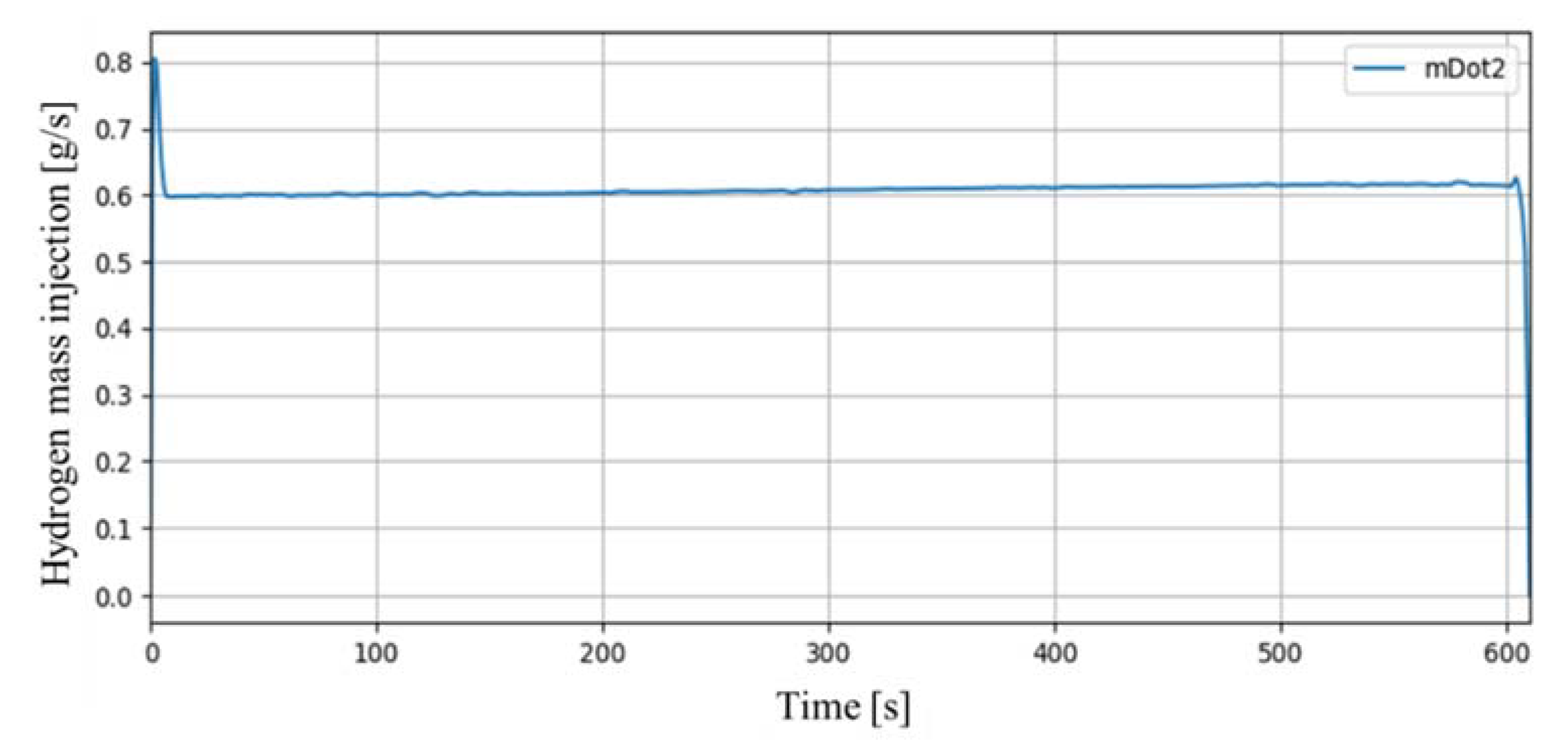
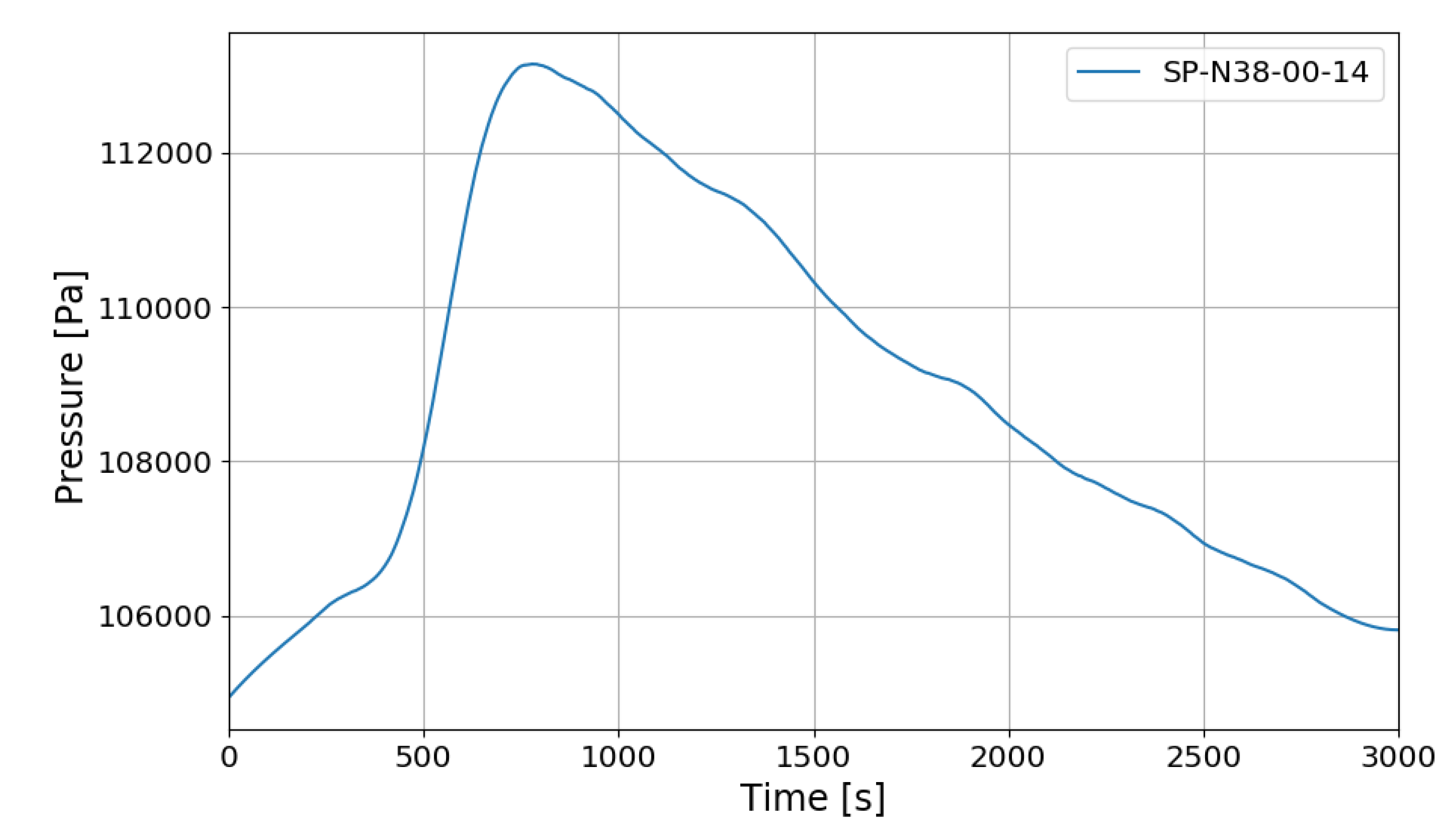
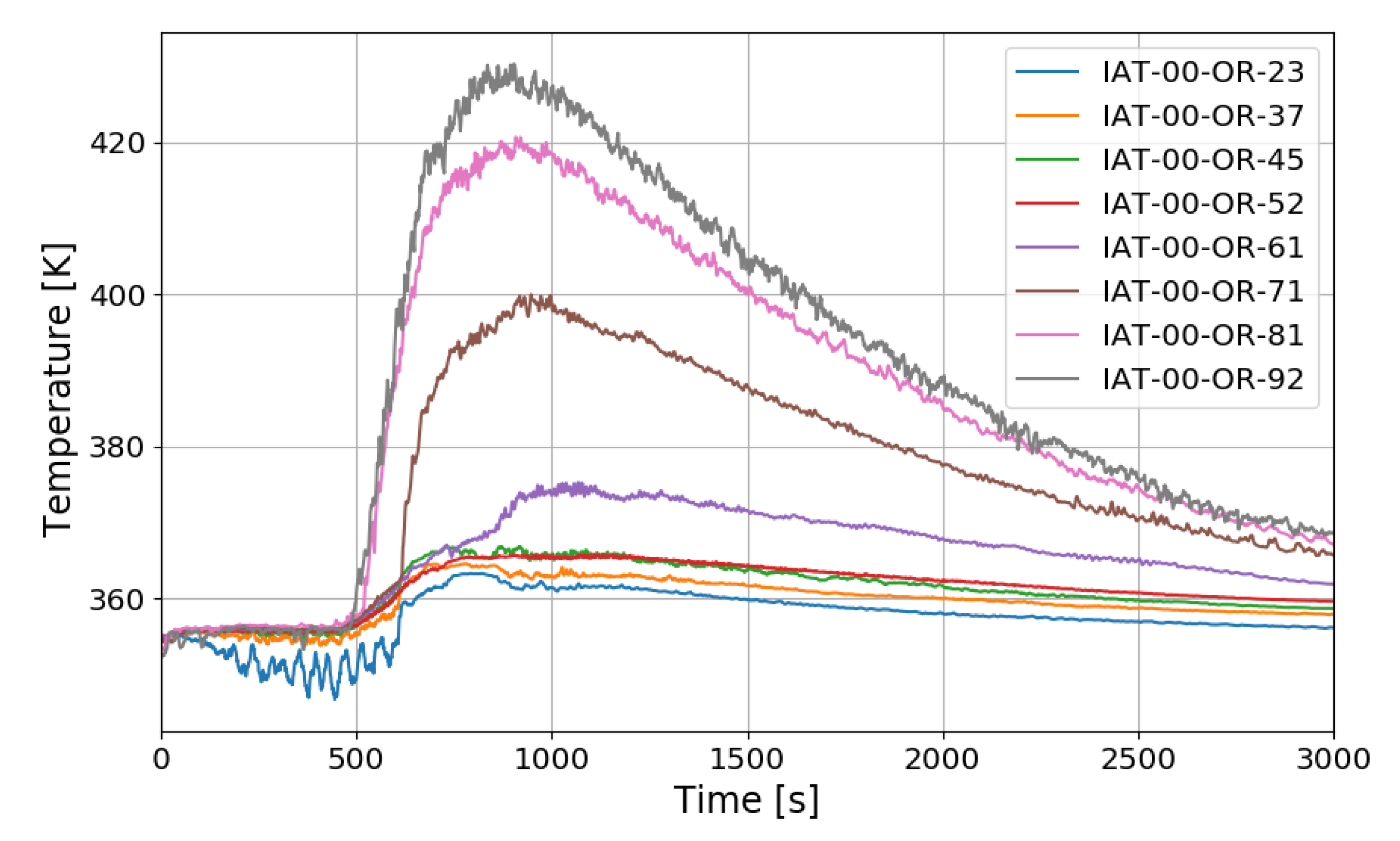

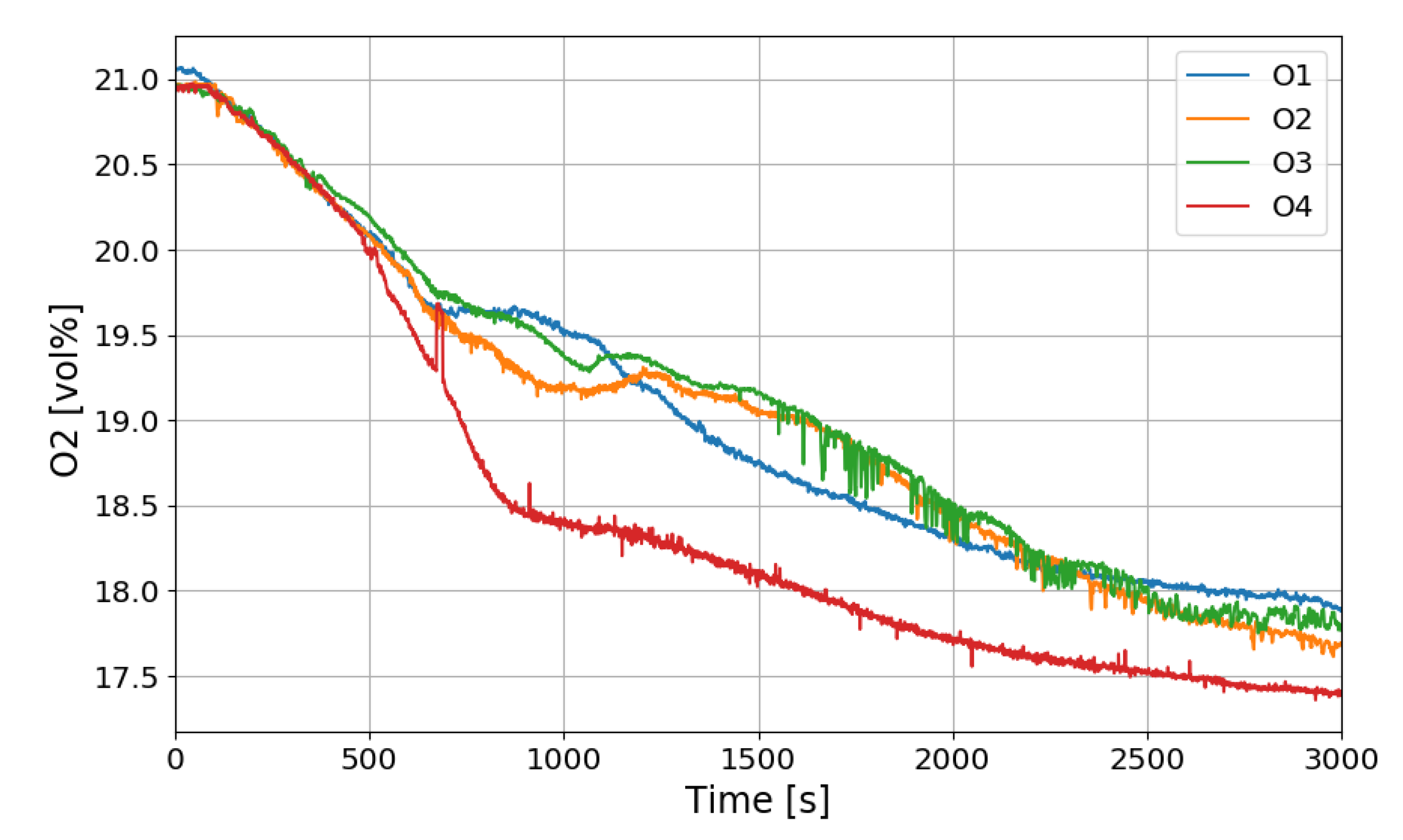
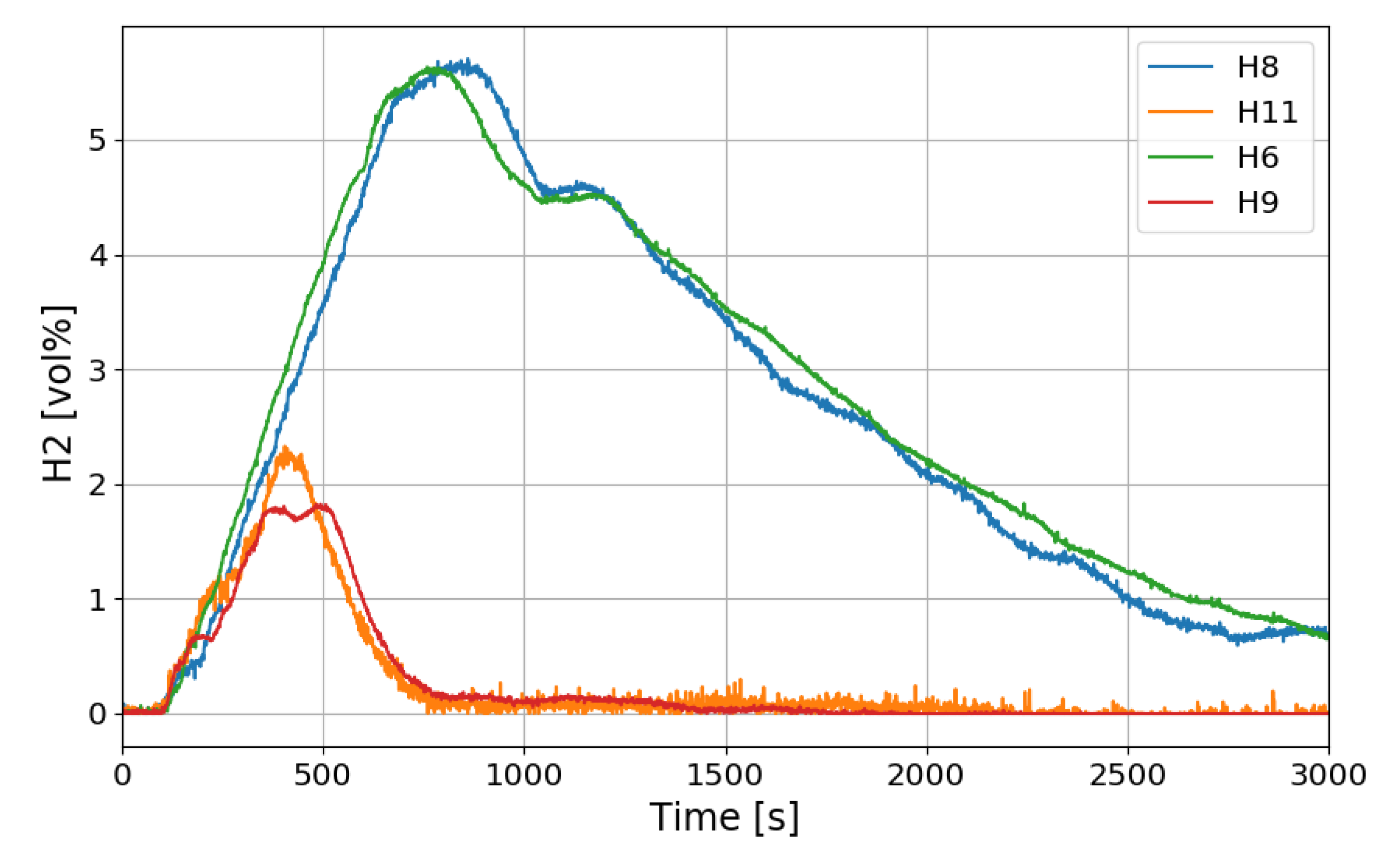

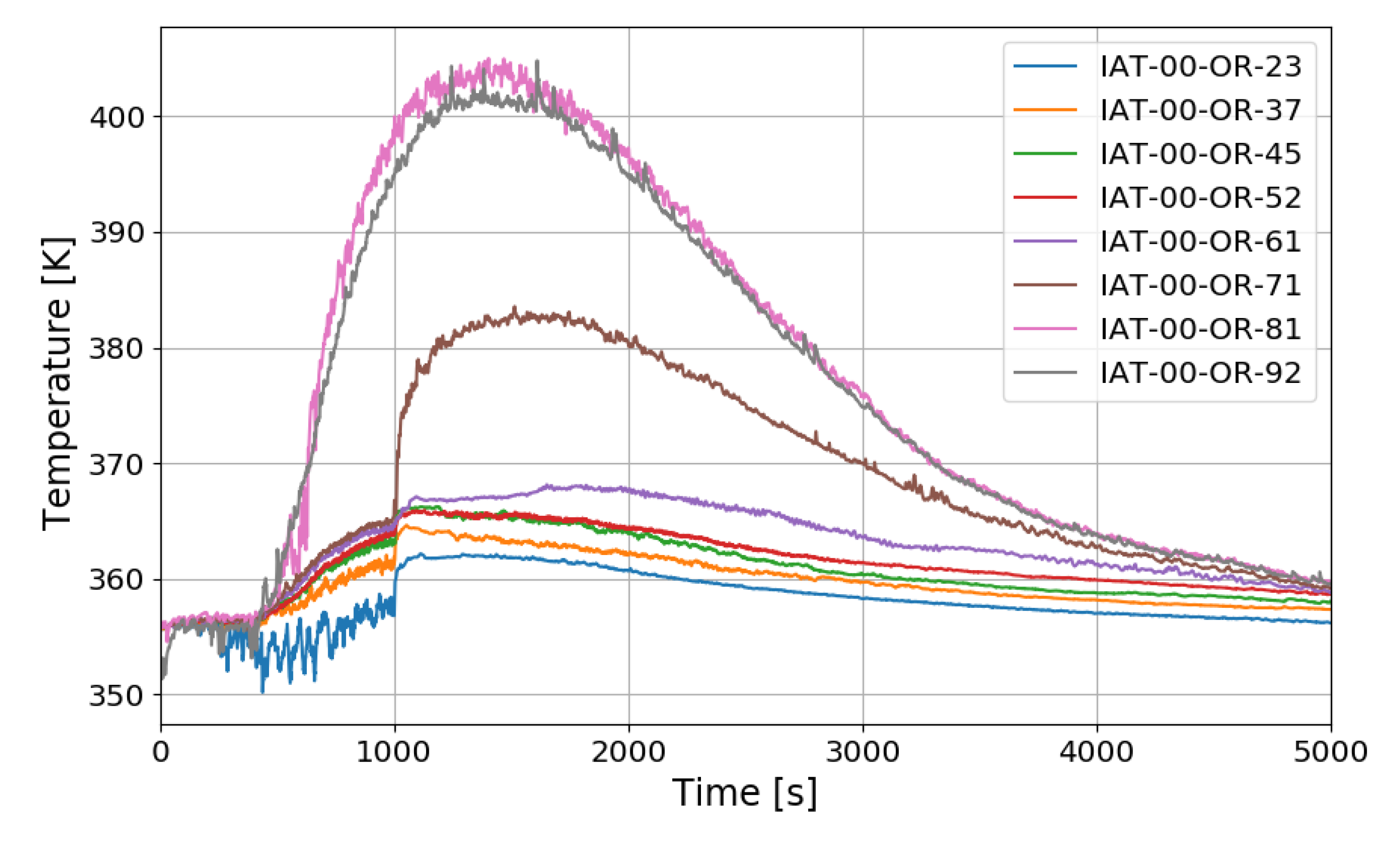
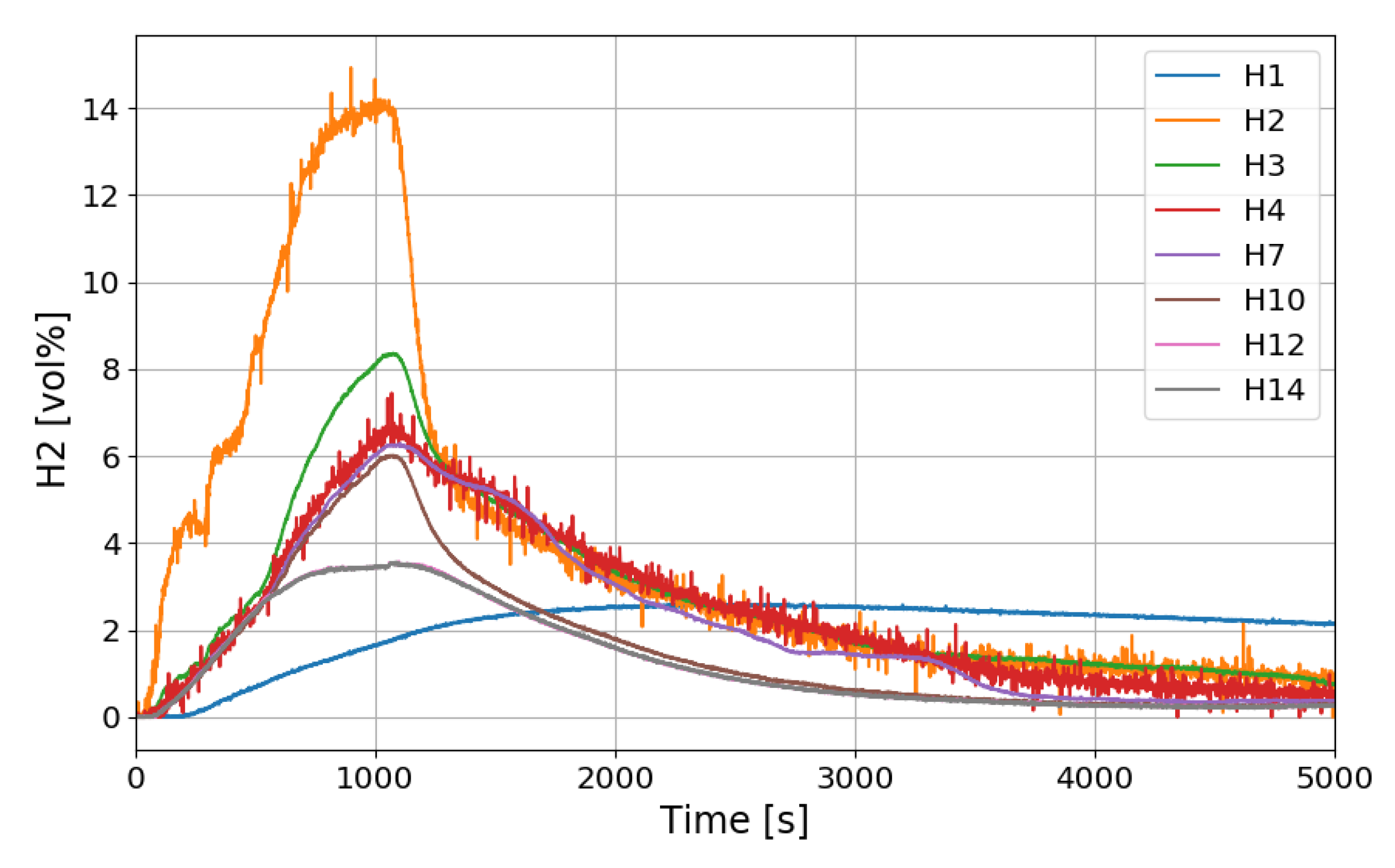




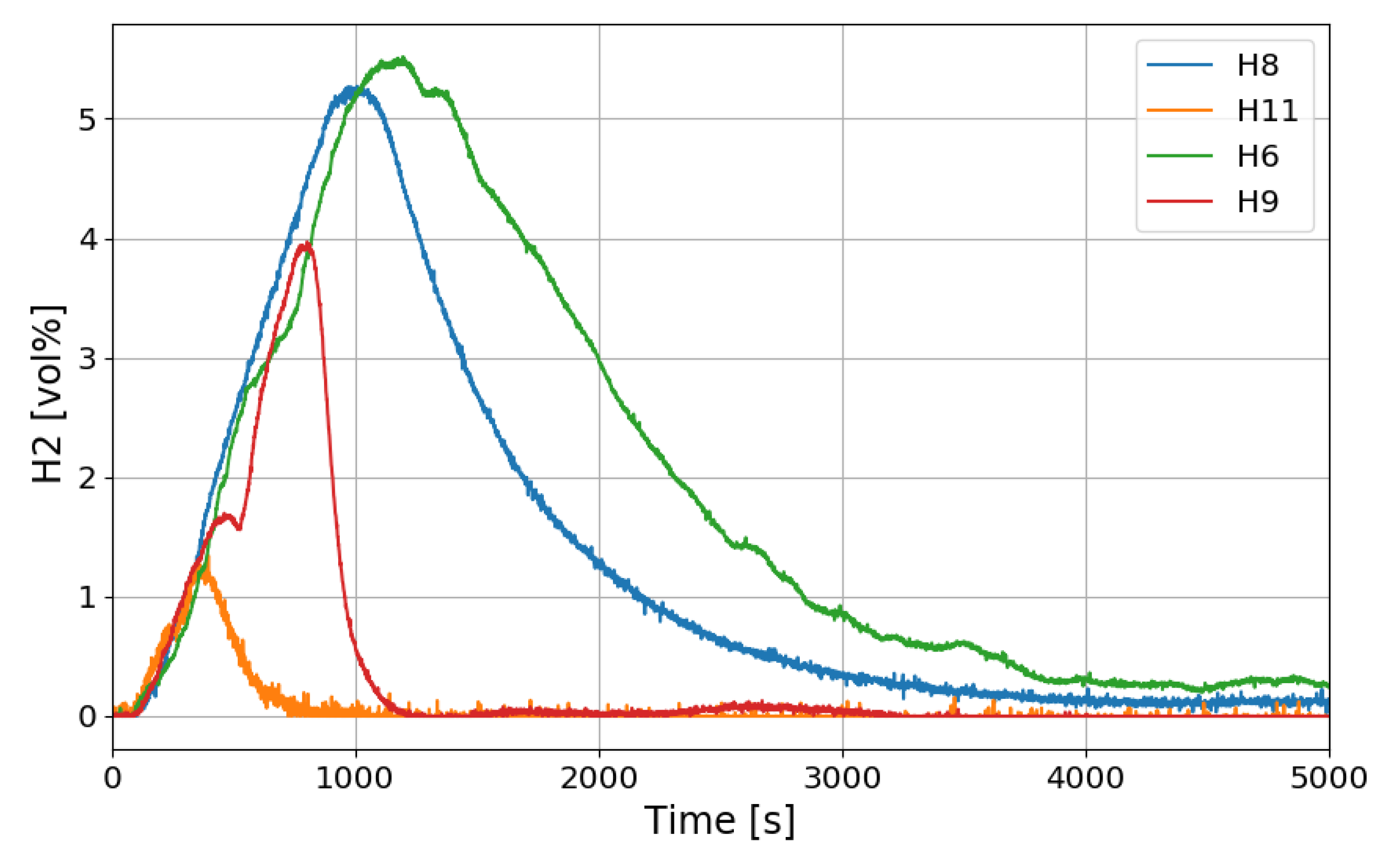
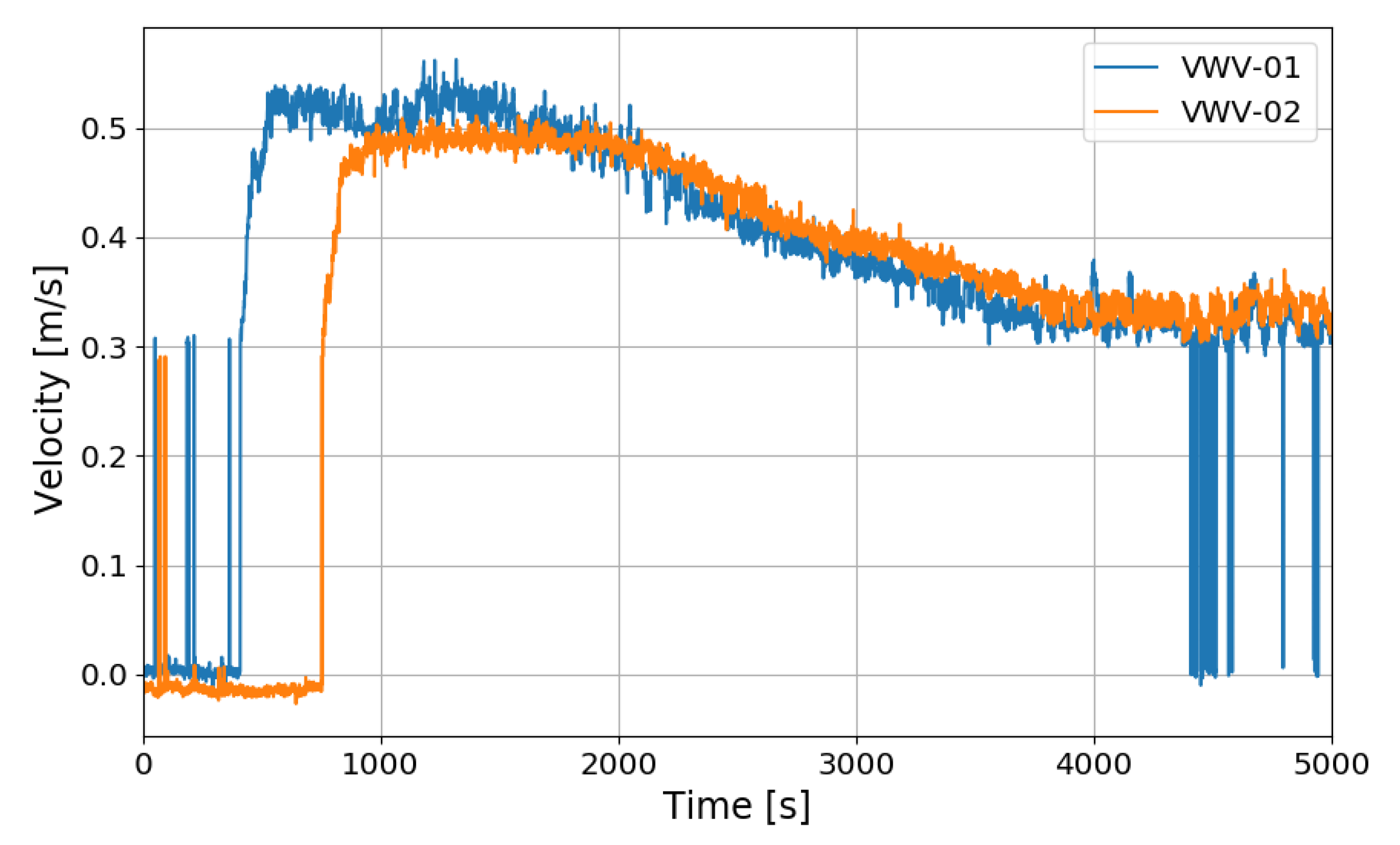
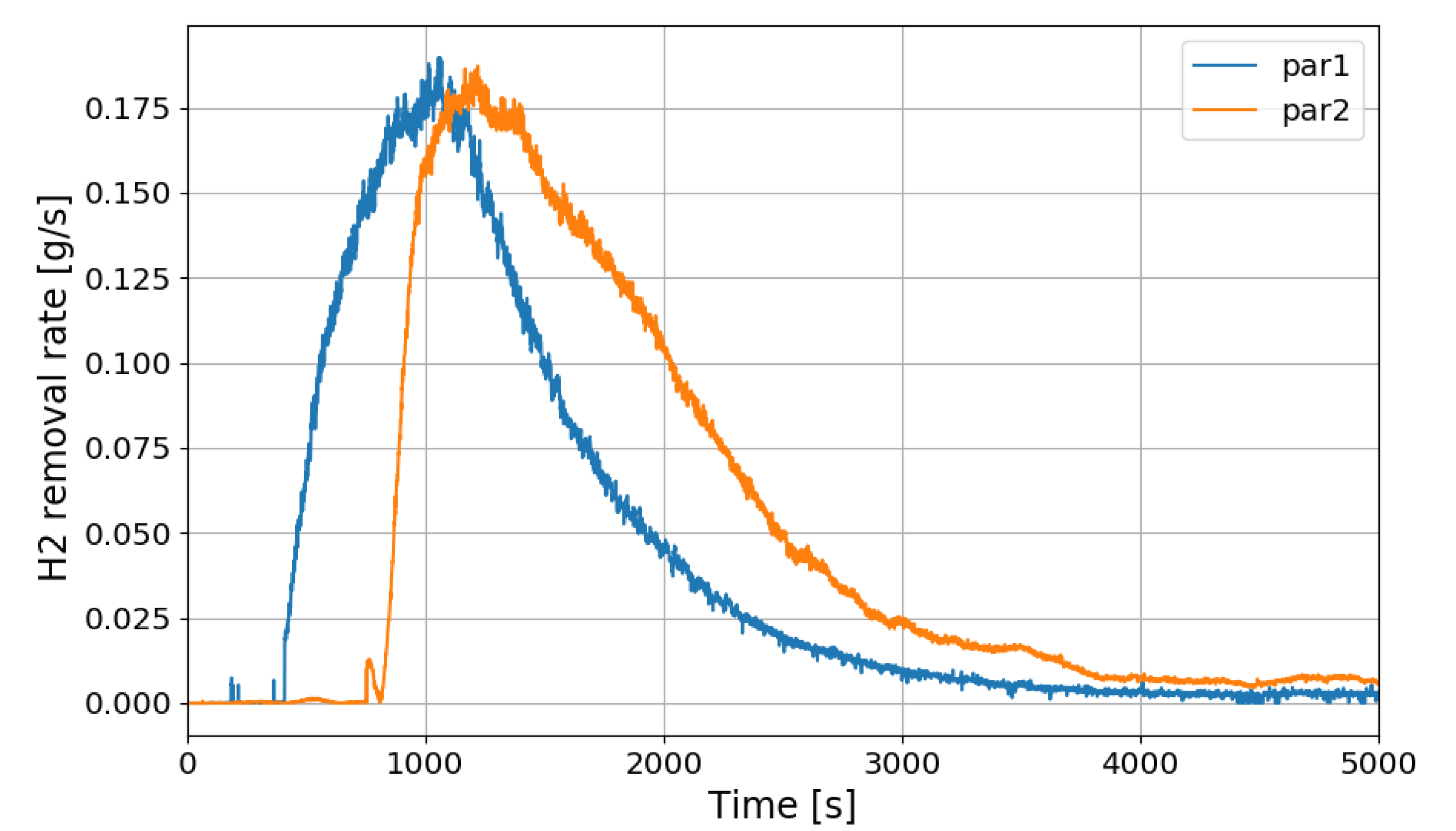
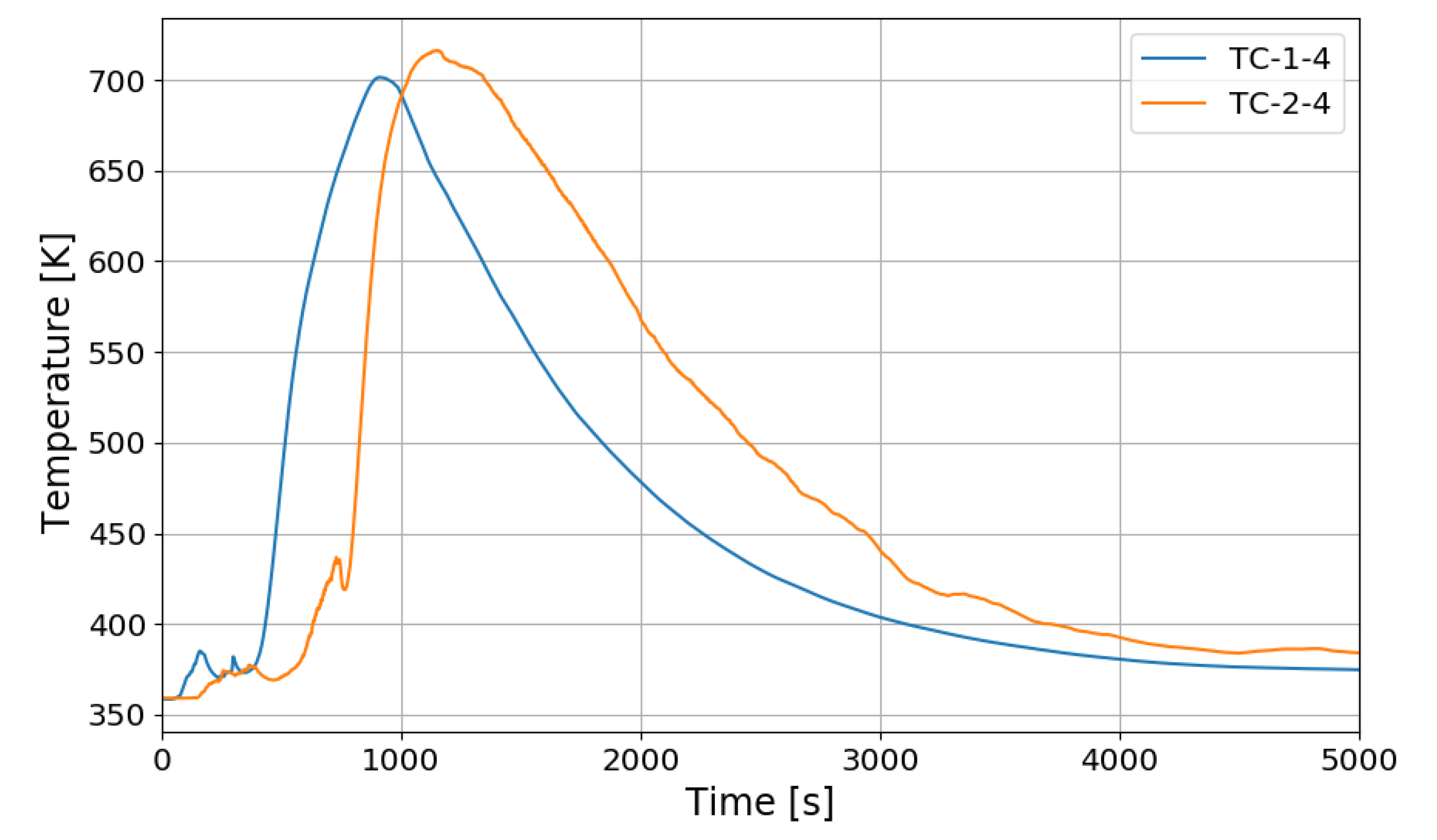
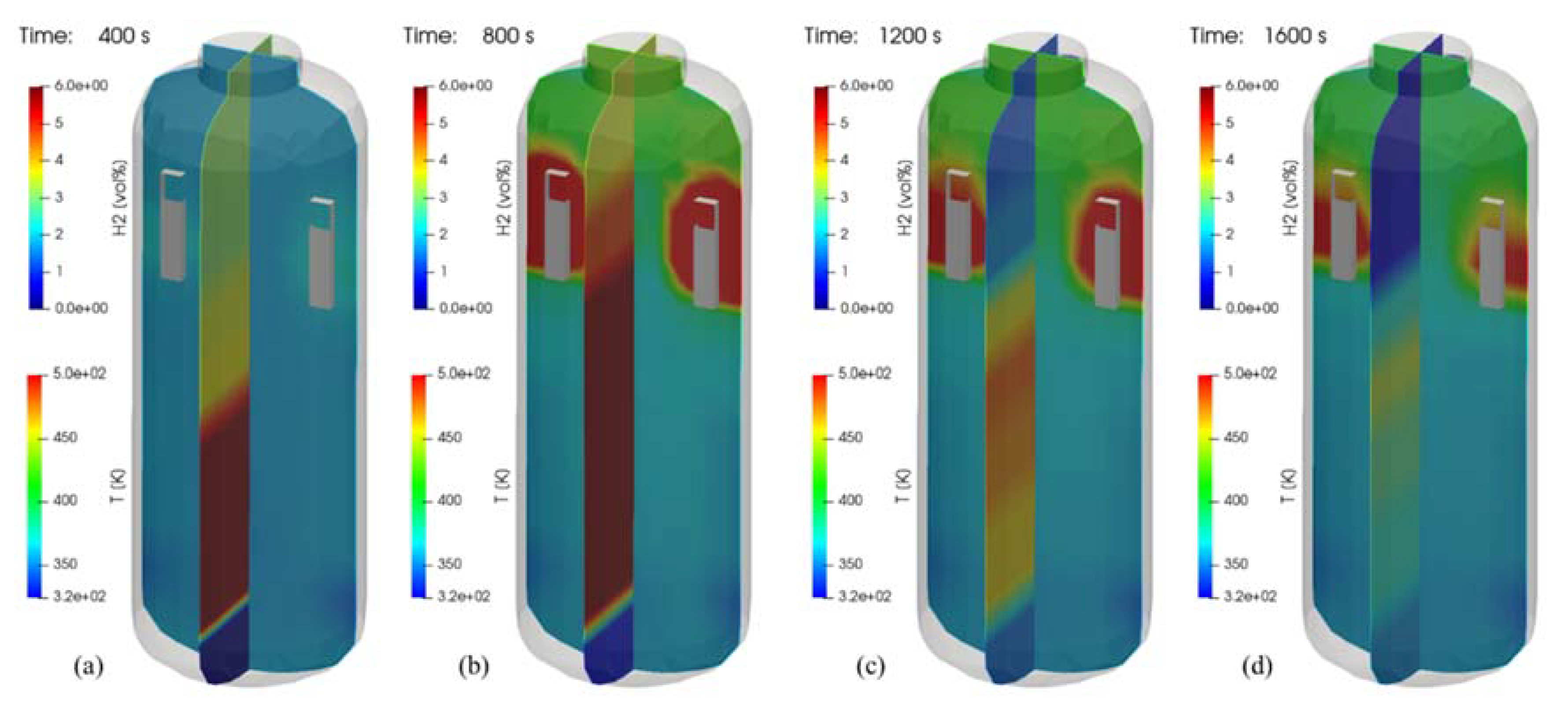
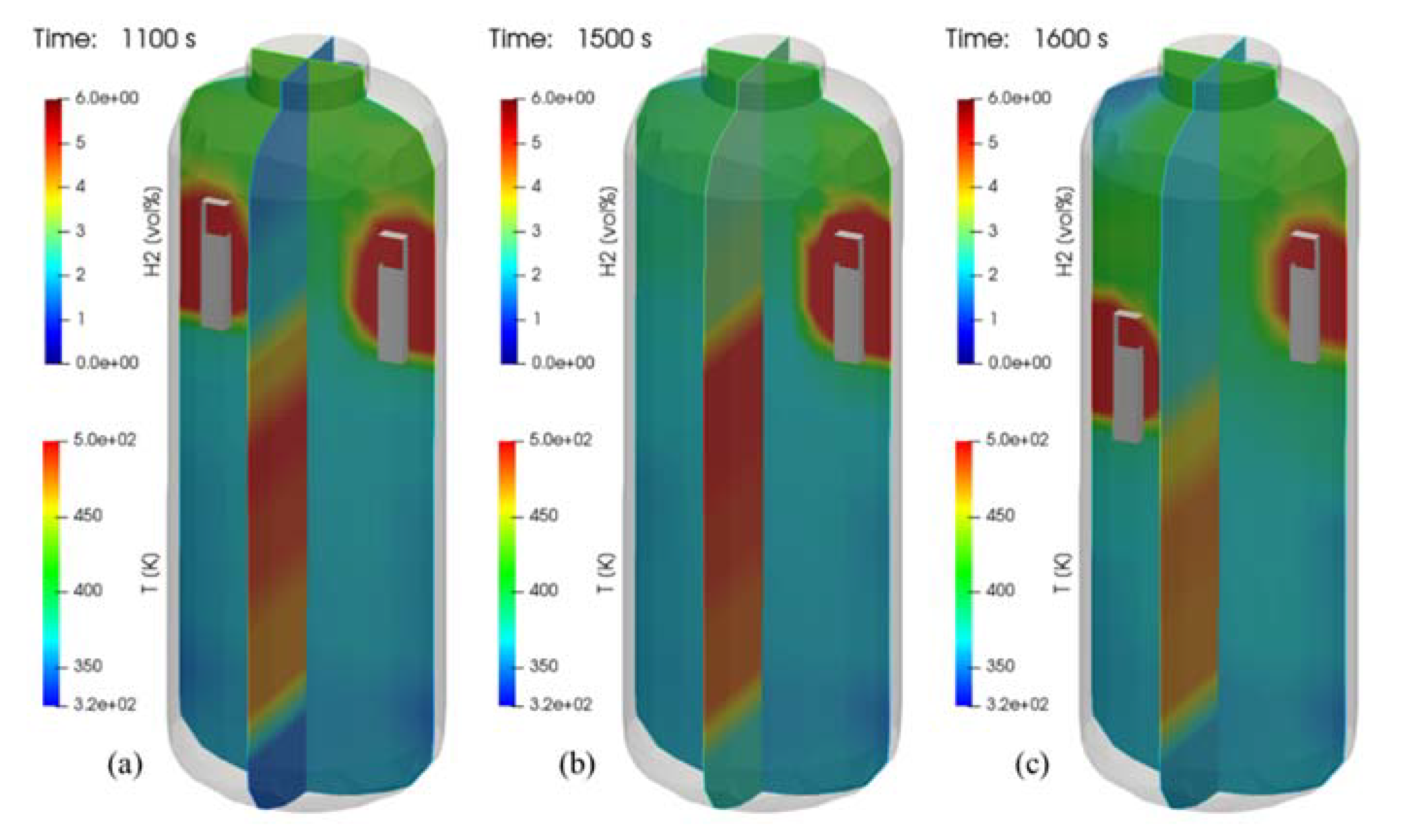
| Characteristic | PAR | Igniter |
|---|---|---|
| Activity | Passive | Active (Signal from Operator or Sensor) |
| Performance | small PAR: about 0.2 g/s (4% H2) large PAR: about 0.8 g/s (4% H2) | diffusion flame: release is burn premixed combustion: deflagration |
| Power | Power supply not required | Power supply required |
| Parameter | Specification |
|---|---|
| Design pressure | 15 bar (at 180 °C) |
| Height | 9.76 m |
| Diameter | 3.4 m |
| Free volume | 82 m3 |
| Wall heating | Oil heating (partly elec. heating) |
| measurements | 14 (H2), 4 (O2), 4 (H2O), 58 (gas temp.), 112 (wall temp.) |
| SPARC-PAR | PAR Installation | Condition |
|---|---|---|
| SP1 | 2 PARs in parallel | , 600 s |
| SP2 | 2 PARs in parallel | , 850 s |
| SP3 | 1 PAR | , 1000 s |
| SP4 | 2 PARs staggered | , 1100 s |
| SP5 | 2 PARs staggered | , 1100 s |
| SP6 | 2 PARs staggered | , 1000 s |
| SP7 | 2 PARs staggered | , 1000 s |
Publisher’s Note: MDPI stays neutral with regard to jurisdictional claims in published maps and institutional affiliations. |
© 2020 by the authors. Licensee MDPI, Basel, Switzerland. This article is an open access article distributed under the terms and conditions of the Creative Commons Attribution (CC BY) license (http://creativecommons.org/licenses/by/4.0/).
Share and Cite
Kim, J.; Hong, S.; Park, K.H.; Kim, J.H.; Oh, J.Y. Experimental Study on a Hydrogen Stratification Induced by PARs Installed in a Containment. Energies 2020, 13, 5552. https://doi.org/10.3390/en13215552
Kim J, Hong S, Park KH, Kim JH, Oh JY. Experimental Study on a Hydrogen Stratification Induced by PARs Installed in a Containment. Energies. 2020; 13(21):5552. https://doi.org/10.3390/en13215552
Chicago/Turabian StyleKim, Jongtae, Seongho Hong, Ki Han Park, Jin Heok Kim, and Jeong Yun Oh. 2020. "Experimental Study on a Hydrogen Stratification Induced by PARs Installed in a Containment" Energies 13, no. 21: 5552. https://doi.org/10.3390/en13215552
APA StyleKim, J., Hong, S., Park, K. H., Kim, J. H., & Oh, J. Y. (2020). Experimental Study on a Hydrogen Stratification Induced by PARs Installed in a Containment. Energies, 13(21), 5552. https://doi.org/10.3390/en13215552




